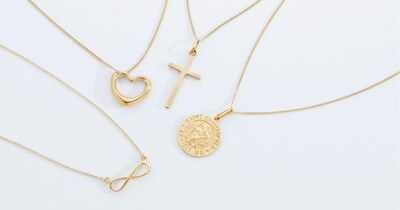Shapes of the Heart: The Story Behind the Five Most Romantic Jewellery Motifs
Whether given to a partner, friend, parent, sibling or child, every piece of jewellery carries meaning and memories.

Certain symbols are inextricably linked to love and have been used to symbolise matters of the heart for centuries. Here, we look at the history behind the five most romantic motifs in the jewellery world.
Infinity
Thought there was nothing sentimental about algebra? Think again: the infinity symbol is where mathematics and romance collide. While the figure-of-eight motif can be traced back to Greek philosophy, it was first used to represent a number with no end by mathematician John Wallis in the 17th century. Also known as a lemniscate, from the Latin for “decorated with ribbons”, the symbol expresses eternal, endless love. Its elegant silhouette parlays beautifully into jewellery: such as this classic 9ct gold pendant by Goldsmiths, the two halves representing two interconnected souls.
Knot
Like the Celtic handfasting ritual, in which a married couple’s hands are tied together – literally, tying the knot – a knot represents love and lasting commitment. Love knots have appeared in jewelled form over the centuries: from Ancient Greek jewellery and Celtic knot rings to sailors’ rope bracelets and Victorian jewels. Symbolic but not saccharine, knots continue to appear in contemporary jewellery design. Here, Goldsmiths sprinkles tightly bound knots with diamonds for a sparkling accessory with a subtle romantic twist.
Flowers
Nothing says ‘I love you’ better than a bouquet of flowers – except an everlasting display wrought from precious metal and gems. Floral jewellery blossomed in the early 19th century after the publication of Le Langage des Fleurs, which assigned meanings to different botanicals: tulips for love, blue violets for faithfulness, ivy for fidelity. Victorians, who loved symbolic jewels, embraced this new language with naturalistic depictions of flowers in diamond brooches, rings, necklaces and tiaras. The trend continued into the enameled blooms of Art Nouveau. Contemporary floral jewels are simpler and more stylised: each petal of Goldsmiths’ dainty 9ct gold flower, for example, is adorned with a single diamond.
Circle
Wedding and eternity bands are an everyday reminder of a couple’s enduring love and commitment: the unbroken circle is a universal symbol of devotion. The circle is a metaphor for wholeness, perfection, and eternity; one of the most ancient and powerful symbols in existence. It’s also one of the most aesthetically pleasing, making it a timeless favourite in jewellery boxes. Goldsmiths sets brilliant-cut diamonds around the circumference of an open circle in this ultra-versatile pendant.
Heart
The most unmistakably romantic emblem of all, hearts have been used since medieval times as a token of love. They were hugely popular in the Victorian era – Queen Victoria owned a bracelet strung with a heart-shaped charm to represent each of her children. In recent years, the heart has become one of the biggest trends in fine jewellery. From Suzanne Kalan’s hearts composed of baguette-cut diamonds to Chopard’s celebrated Happy Hearts collection and Gucci’s logo-adorned designs, there’s a heart to suit any style. Here, Goldsmiths embellishes a Sterling Silver version with a sparkling 0.10ct diamond.
Explore more romantic jewellery here at Goldsmiths online or visit one of our showrooms.
Author Credit: Sarah Royce-Greensill is the Jewellery & Watches Editor at The Telegraph, where she covers everything from royal tiaras to the latest trends in fine jewellery. She is also a contributor to Vanity Fair, Conde Nast Traveller, Tatler and Country Life, among other titles.

